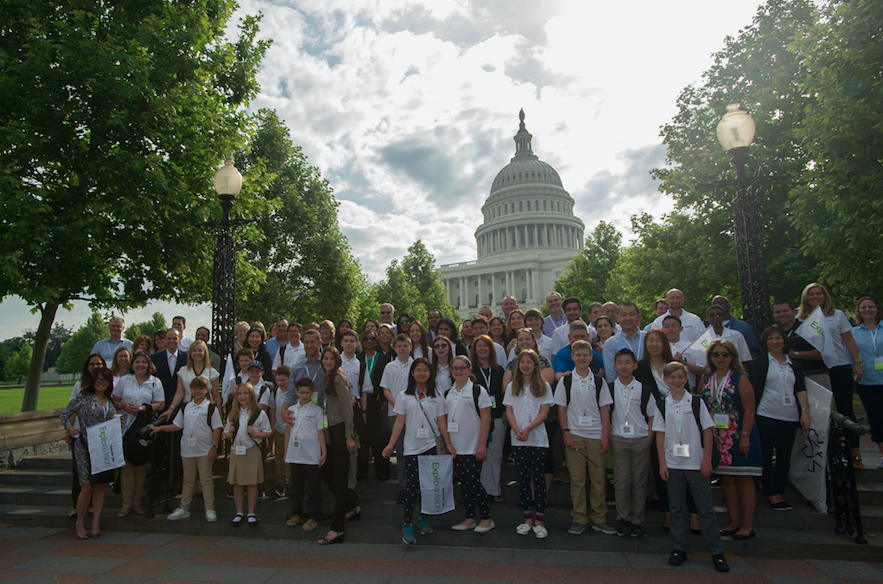Within 20 Years, These 8 Inventions Could Become Reality
By Korei Martin
Posted on 2018-06-25

Imagine if you were asked what technology would look like in two decades. Through our ExploraVision science competition, that very same question has fueled over 400,000 young minds in the U.S. and Canada for 26 years. This year, nearly 5,000 students from Kindergarten through 12th grade imagined ways to solve or treat common issues in agriculture, healthcare, energy storage and much more.
For over two decades, Toshiba America and the National Science Teachers Association have joined forces through ExploraVision to encourage the next generation to think big and have a role in shaping a better future. We believe that investing in early STEM education and project-based learning can foster a lifelong passion for innovation that leads to scientific breakthroughs.
From June 7-8, we gathered all eight ExploraVision winning teams in Washington, D.C. to exhibit their forward-thinking projects to elected officials, members of the media, and Toshiba Corp executives. From finding a potential cure for Cystic Fibrosis to increasing the efficiency of electric cars, this year’s national ExploraVision winners truly proved themselves to be the future generation of STEM changemakers.
Rethinking the Future of Solar Energy

Science is all about paving the way for a brighter future, and these high school students from Ward Melville High School in East Setauket, NY are doing just that—with sun. They envisioned a way to improve the efficiency of solar energy using 3D printed carbon nanotubes. Now that’s what we call clean technology.
Ending Lupus with Two-Drug Combination Therapy

A cure for Lupus has long eluded scientists and medical professionals, but these Academy of Arts and Sciences high school students from Granada Hills, CA decided to tackle the disease with a combination of pre-existing therapies. The two-drug cell therapy these young health scientists invented could shape healthcare in 20 years.
A New Way to Treat Autism with Wearable Technology

Inspired by a classmate with Autism, these students from Saint Anthony’s High School in South Huntington, NY developed a way for people on the spectrum to navigate confusing social situations. The EMREC smart bracelet they invented creates fun, personalized therapies for patients to improve emotional recognition abilities. Wearable devices that incorporate IoT and Bluetooth technology are the future of healthcare.
Making Language Visual with Augmented Reality

Imagine a world where everyone could understand each other, and language wasn’t a barrier to communication. That’s exactly what this sibling duo from The Gagie School in Kalamazoo, MI had in mind when they developed their Word Watch headset. This augmented reality headset/goggle combination can translate any verbal words into a visual text the wearer understands. Word Watch ultimately helps improve personal or professional relationships globally.
Treating Cystic Fibrosis with Nano-Sponge Technology

When these middle school students from Plainview-Old Bethpage Middle School in Plainview, NY learned their Vice Principal’s granddaughter suffered from Cystic Fibrosis, the turned empathy into innovation. The CFAST system uses nano-sponge technology to absorb excess mucus in patients’ lungs, leading the world one step closer to finding a cure for CF.
Maximizing the Efficiency of Electric Cars

At Toshiba, we know the future of transportation rests on electric vehicles. Similarly, middle schoolers at St. Brother Andre School in Ottawa, Canada found a more sustainable way to harness energy. Their Perpetual Energy Motor makes electric vehicles more efficient between charges to better manage energy. This motor could become a reality in the next several years.
Improving Crop Yield with IoT Devices

As the world’s population continues to grow, how can farmers modernize agriculture? These elementary school students from L.D. Batchelder School in North Reading, MA think the answer lies in wireless IoT devices. The iSWARM would use sensors to give farmers updates about the health of their crops in real-time. Over time, this will help improve crop yield and change the face of agro-technology.
A Unique Smart Toilet to Manage Illness

These elementary school students from St. Thomas the Apostle in Miami, FL believe that many illnesses could be prevented if symptoms were detected early on. That’s why they invented the Smart Toilet, which monitors bodily fluids and sends results to a smartphone app. With this kind of technology, the future of healthcare becomes more personal and meaningful.
The ground-breaking work these national ExploraVision winners created is a testament to the importance of encouraging scientific exploration in young students. We are proud to provide them with educational savings bonds and other prizes to inspire their next big ideas. Learn more about ExploraVision.
Photos Courtesy of Jax Photography
Disclaimer: The views expressed in this blog post are those of the author(s) and do not necessarily reflect the official position of the National Science Teaching Association (NSTA).

